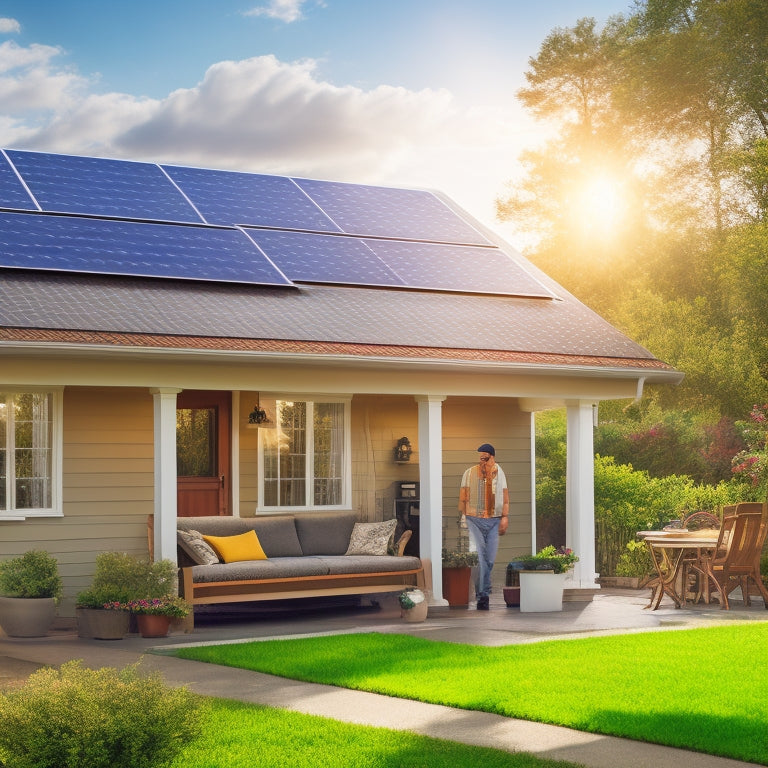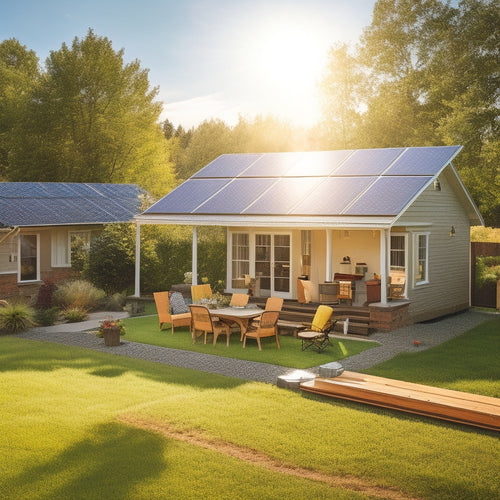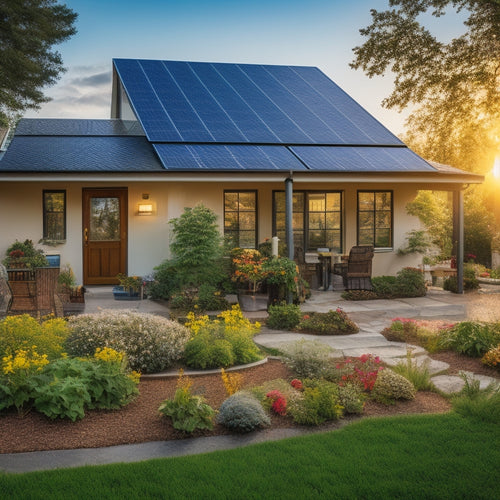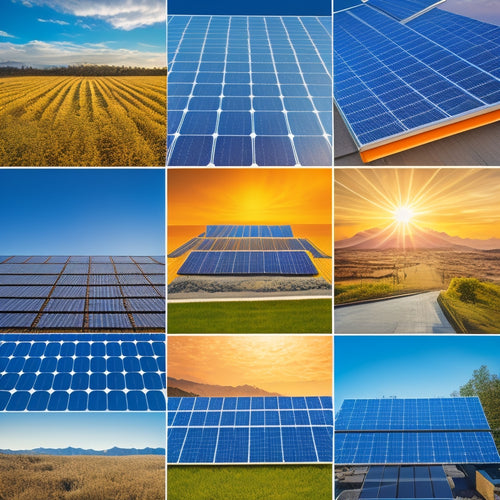
What Is the Cost of Installing a House Solar System
Share
You can expect to pay between $15,000 and $30,000 for a typical residential solar panel system, with an average cost per watt ranging from $2.50 to $3.50. However, this cost can vary depending on factors such as the complexity of the installation, location, and installer experience. Additionally, you may need to take into account permitting and inspection fees, as well as the cost of mounting and tracking systems. With federal tax credits and utility rebates available, you can lower your upfront costs. As you investigate your options, you'll want to take into account the size and configuration of your system, equipment quality, and local incentives to guarantee you're getting the best value for your investment - and that's just the beginning.
Key Takeaways
- The average cost of a solar panel system ranges from $15,000 to $30,000, with an average cost per watt of $2.50 to $3.50.
- Financing options, federal tax credits, and utility rebates can lower upfront costs and make solar energy more accessible.
- Installation costs vary based on complexity, location, and installer experience, with labor costs including wages, benefits, and equipment expenses.
- The cost of a solar system also depends on the quality and brand of equipment, with high-quality equipment affecting performance, durability, and cost.
- Ongoing maintenance and upkeep costs, including panel cleaning and inverter inspections, should be factored into long-term budgeting.
Average Cost of Solar Panels
On average, a homeowner can expect to pay between $15,000 and $30,000 for a solar panel system, with the average cost per watt ranging from $2.50 to $3.50.
This upfront cost may seem intimidating, but you'll be pleased to know that solar panel financing options are available to help make the shift to renewable energy more affordable. Many solar panel manufacturers and installers offer financing plans with flexible repayment terms, allowing you to spread the cost over several years.
When considering the cost of solar panels, it's crucial to factor in the system's longevity. A well-maintained solar panel system can last for up to 30 years or more, providing a significant return on investment over its lifespan.
With proper care, your solar panels will continue to generate electricity at ideal levels, reducing your reliance on the grid and saving you money on your energy bills.
Installation Costs and Factors
You've factored in the cost of the solar panels themselves, but what about the installation costs? This is a significant aspect of the overall cost of installing a house solar system. Installation costs can vary widely depending on several factors, including the complexity of the installation, the location, and the installer's experience.
Some key factors that affect installation costs include:
-
Labor costs: The cost of hiring a professional installation team, including their wages, benefits, and equipment costs.
-
Permitting and inspections: Fees associated with obtaining necessary permits and passing inspections.
-
Mounting and tracking systems: The cost of installing tracking systems that maximize energy output and durability.
When considering installation costs, it's important to also think about financing options and the installation timeline.
Will you need to secure a loan or investigate other financing options to cover the upfront costs? How long will the installation process take, and what kind of disruption can you expect to your daily routine?
System Size and Configuration
You'll need to evaluate three key aspects when determining your system's size and configuration: system capacity options, which range from 2-10 kilowatts or more; panel array design, including the number of panels, their layout, and orientation; and inverter type selection, which affects how efficiently your system converts DC power to AC.
These factors will impact not only your system's overall performance but also its cost. By carefully assessing these points, you can optimize your system's design to meet your energy needs and budget.
System Capacity Options
Your solar panel system's capacity is a critical factor in determining how much electricity it will generate and, ultimately, how much you'll save on your utility bills. The capacity of your system is measured in watts (W) and typically ranges from 2,000 to 20,000 watts. A higher capacity system will generate more electricity, but it will also be more expensive.
When selecting a system capacity, consider the following factors:
-
Your energy usage: If you have high energy usage, you'll want a larger system to meet your energy demands and maximize your energy savings.
-
Your roof size and layout: The size and layout of your roof will dictate how many panels you can fit, and consequently, the maximum capacity of your system.
-
Local building codes and regulations: Check with your local government to see if there are any restrictions on system capacity or size.
Keep in mind that a larger system doesn't always mean better system performance. A properly sized system that matches your energy usage and roof constraints will provide ideal energy savings and system performance.
Panel Array Design
The panel array design of your solar system, which encompasses system size and configuration, plays an important role in determining the overall performance and efficiency of your solar installation. This involves calculating the ideal system size based on your energy needs, available roof space, and local building codes. You'll also need to take into account the solar panel orientation, which affects the system's energy output. A south-facing orientation is generally favorable, but you may need to adjust this based on your roof's design and surrounding obstructions.
A thorough shading analysis is vital to identify potential obstructions, such as trees or neighboring buildings, that may impact your system's performance. This analysis will help you determine the best configuration for your panel array.
| Design Consideration | Impact on System Performance |
|---|---|
| Solar panel orientation | Energy output |
| Shading analysis | System efficiency |
| System size and configuration | Overall performance |
Inverter Type Selection
As the panel array design takes shape, attention turns to the inverter type selection, a crucial aspect of system size and configuration. You'll need to choose an inverter that efficiently converts DC power from the solar panels to AC power for your home.
When selecting an inverter, you should consider the following factors:
-
Inverter efficiency: Look for an inverter with high efficiency ratings (95% or higher) to minimize energy losses and maximize your system's overall performance.
-
Inverter lifespan: A longer inverter lifespan (25 years or more) means fewer replacement costs and less electronic waste.
-
Compatibility and scalability: Verify the inverter is compatible with your panel array design and can adapt to potential future system expansions.
A suitable inverter won't only optimize your system's energy output but also provide a reliable and long-lasting solution.
Equipment Quality and Brand
Installing a high-quality solar panel system requires careful evaluation of equipment quality and brand, given that they can considerably impact the system's performance, durability, and overall cost.
You'll want to choose reputable brands with a proven track record of supplying high-efficiency solar panels and inverters that can withstand various environmental conditions.
A brand's reputation is essential, as it often reflects the quality of its products and services. Look for brands that have been in the industry for a significant period and have a history of producing reliable equipment.
A well-established brand is more likely to provide better warranties, maintenance, and support, which can save you money and hassle in the long run.
The equipment's lifespan is also a vital factor to evaluate. High-quality solar panels, for instance, can last up to 30 years or more, while low-quality ones may degrade faster, reducing their energy output and requiring more frequent replacements.
Local Incentives and Rebates
While evaluating the cost of installing a house solar system, you shouldn't overlook the impact of local incentives and rebates, which can greatly reduce your upfront expenditure.
These incentives can come in various forms, including federal tax credits, utility rebates, and state incentives. By taking advantage of these offers, you can considerably lower the cost of your solar system installation.
Some local incentives and rebates you may be eligible for include:
-
Utility rebates: Many utility companies offer rebates to customers who install solar systems, which can help offset the cost of installation.
-
State incentives: Many states offer additional incentives, such as tax credits or grants, to encourage the adoption of solar energy.
-
Financing options: Some local governments and organizations offer financing options, such as low-interest loans or property tax assessments, to help you cover the cost of installation.
Roof Size and Condition
When you're planning to install a house solar system, you'll need to take into account your roof's size and condition.
A larger roof provides more space for solar panels, but it also increases the installation cost.
Additionally, the condition of your roof - including its age and any signs of wear - will impact the system's efficiency and the installation process itself.
Roof Size Matters
Your roof's real estate plays an essential role in determining how many solar panels you can fit, and ultimately, how much energy you can generate. The size of your roof will impact the number of panels you can install, and subsequently, the amount of electricity you can produce.
When evaluating your roof's potential, consider the following factors:
-
Roof orientation: A south-facing roof receives the most sunlight throughout the day, making it ideal for solar panels. East- and west-facing roofs also work well, but north-facing roofs are less suitable.
-
Shading analysis: Trees, chimneys, and other obstructions can cast shadows on your roof, reducing the amount of energy your solar panels can generate. A thorough shading analysis will help identify the best placement for your panels.
-
Available space: The size and shape of your roof will dictate how many panels can be installed. A larger roof with more available space can accommodate more panels, increasing your energy output.
Condition Affects Efficiency
The roof's condition greatly impacts the efficiency of your solar system, as it directly affects the performance of the installed panels. A damaged or old roof can lead to reduced solar panel efficiency, which in turn increases your energy bills and reduces the environmental impact of your solar system.
You should verify your roof is in good condition before installing solar panels.
Additionally, the type of roofing material you have can also affect the installation process and overall cost. For instance, if you have a clay or slate tile roof, it may require additional labor and materials to guarantee the solar panels are securely fastened, increasing the overall cost.
On the other hand, a standard asphalt shingle roof is typically easier to work with, reducing installation costs.
It's crucial to evaluate these factors when planning your solar system installation to maximize its efficiency and minimize its environmental impact.
Age Impacts Installation
As you prepare for solar panel installation, it's imperative to contemplate the age of your roof, as it directly impacts the installation process and overall cost.
Age considerations play a significant role in determining the feasibility of solar panel installation. If your roof is old or nearing the end of its lifespan, you may need to replace it before installing solar panels. This adds to the overall cost, but it's vital to guarantee the integrity of your roof and the safety of the installation.
Some installation challenges you may face due to an older roof include:
-
Structural issues: Older roofs may not be able to support the weight of solar panels, requiring additional structural reinforcements.
-
Roof replacement: If your roof is old, it may need to be replaced before installing solar panels, adding to the overall cost.
-
Inspection and repair: Older roofs may require more thorough inspections and repairs before installation, increasing labor costs.
Keep in mind that these installation challenges can increase the overall cost of your solar panel installation.
Be sure to factor these age considerations into your budget to guarantee a successful and cost-effective installation.
Maintenance and Upkeep Costs
Optimizing your solar system's performance requires regular maintenance and upkeep, which comes with associated costs. As a homeowner, it is vital to factor in these expenses to guarantee your system runs efficiently and effectively.
Solar maintenance involves inspecting and cleaning your panels, inverting systems, and monitoring performance. Upkeep expenses can include:
| Task | Frequency | Cost |
|---|---|---|
| Panel cleaning | Quarterly | $100-$300 |
| Inverter inspection | Annually | $200-$500 |
| System monitoring | Ongoing | $50-$100 per year |
| Repair and replacement | As needed | $500-$2,000 |
| Professional maintenance package | Annually | $500-$1,500 |
These costs may seem significant, but they're vital to maintaining your system's performance and extending its lifespan. Regular maintenance can help you avoid costly repairs, guarantee your system operates at peak efficiency, and maximize your energy savings. By factoring in these expenses, you can enjoy the long-term benefits of solar power while minimizing unexpected costs.
Frequently Asked Questions
Can I Install Solar Panels on a Metal or Tile Roof?
You can install solar panels on a metal or tile roof, but you'll need to verify roof compatibility and consider installation factors like structural integrity, waterproofing, and mounting system design to guarantee a secure and efficient setup.
Do Solar Panels Increase My Home's Value?
You're probably thinking solar panels will devalue your home, but ironically, they'll enhance its appeal; according to a home appraisal, solar incentives can increase your property's value by up to 17%, making it a smart investment for you.
Will Solar Panels Work During a Power Outage?
You're wondering if your solar panels will still work during a power outage. Unfortunately, they typically won't, as they're grid-tied and shut off for safety reasons; however, you can consider adding a battery backup system for continuous power outage solutions and maintaining solar panel functionality.
Can I Add More Panels to My Existing System Later?
You can easily expand your solar panel setup later, but you'll need to guarantee system compatibility; consult your installer to determine the best approach for your solar panel expansion, considering factors like inverter capacity and panel compatibility.
Are Solar Panels Resistant to Hail and Extreme Weather?
You'll be glad to know that modern solar panels are designed to withstand extreme weather conditions, with durability tests simulating hail storms and heavy snow loads, ensuring their performance remains unaffected even in harsh climates.
Conclusion
As you weigh the pros and cons of going solar, the final tally is clear: the cost of installing a house solar system is a significant investment, but one that pays dividends in the long run. Like a puzzle, each factor - system size, equipment quality, and local incentives - fits together to form a complete image of your upfront costs. With careful planning, the pieces will fall into place, illuminating a brighter, more sustainable future for your home and your wallet.
Related Posts
-

Steps to Prepare for Solar Installation
To prepare for solar installation, start by evaluating your current energy consumption and future needs to determine ...
-

How to Achieve Energy Independence at Home
To achieve energy independence at home, start by investing in renewable energy sources like solar panels, wind turbin...
-

Comparative Analysis of Top Solar Brands
To conduct a comparative analysis of top solar brands, focus on key metrics like durability, energy efficiency, and s...


